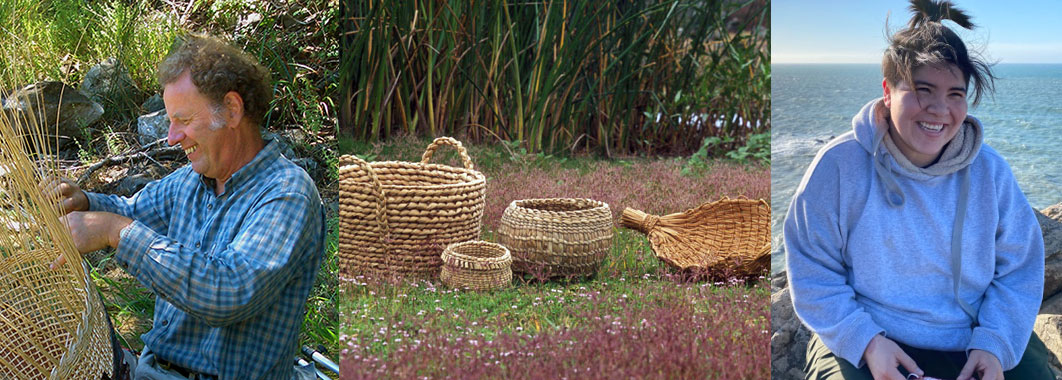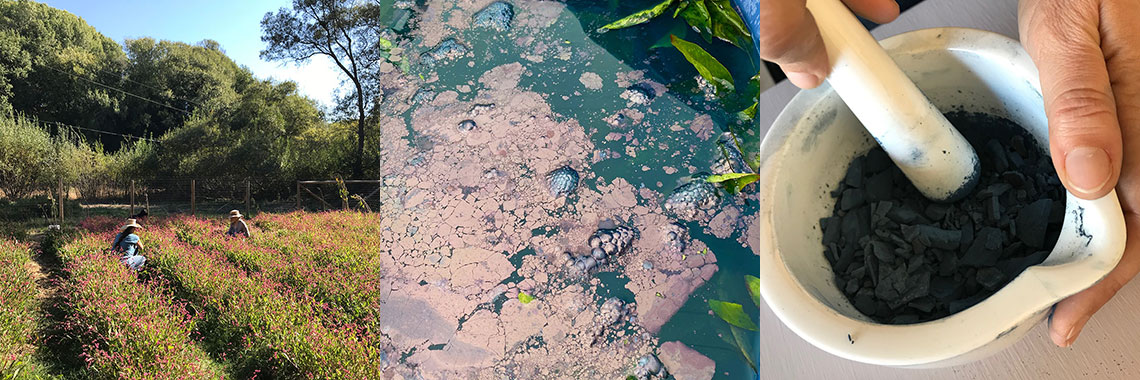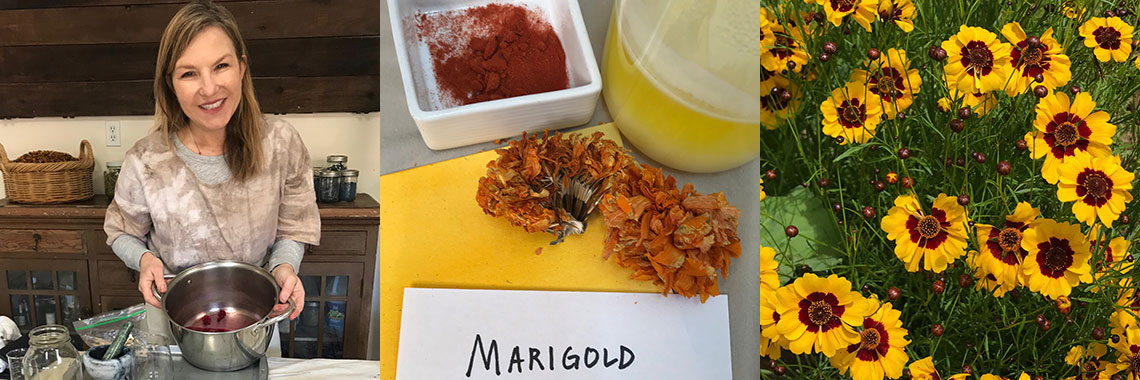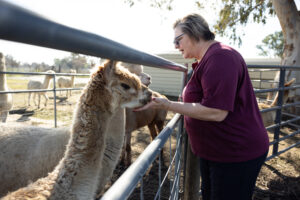Learning Center Opening Workshops
On September 18, 2021, our Northern California Fibershed Learning Center will hold a soft grand opening, celebrated through classes that will provide hands-on skills to the community, as well as time to gather in appreciation of local design community graduates who generated beautiful textiles within Fibershed’s Zero-Waste design challenge.
Hands-on Workshops
Small, intimate courses will be offered—focused on textile repair, weaving with native plant fibers, and pigment making from plants grown in Fibershed’s pigment garden. If you’re most comfortable being outdoors within small group settings, the basketry class and two pigment-making classes will occur in open-air environments. Two Sashiko mending classes will take place indoors for those that are comfortable with that setting.
Gallery Showcase: Fibershed Design Challenge by FIDM Student Designers
The Fibershed Learning Center Opening will feature a display of design work and prototype garments completed by recent graduates of the Fashion Design Program at the Fashion Institute of Design and Merchandising (FIDM)- San Francisco. Garments were constructed as part of the Fibershed Design Challenge at FIDM, using regionally sourced fabric made of Climate Beneficial wool from Lani’s Lana in Modoc County and woven by Huston Textile Company in Sacramento County. The garments reflect creative design skills to achieve ‘zero waste’. This design concept utilizes the complete fabric yardage in garment construction, honoring the preciousness of these textile materials.
Student Designers honored in the Fibershed Design Challenge for their work include: Esther Gaor, Isabelle Leong, Vivica Rafael, Jonnieann Soper and Cortney Sumpter.
Class descriptions and registration links can be found below. We expect these classes to fill quickly. To make the Learning Center Opening available to more people, attendees are asked to only purchase a ticket for one of the five workshops taking place that day. If additional tickets are purchased, one will be canceled. Also, to follow COVID-19 protocols, we ask that non-vaccinated attendees wear a mask. Thank you for your consideration.
For more information, email learningcenter@fibershed.org.
SOLD-OUT: Make a Twined Basket of Tule with Charlie Kennard and Charlena Valencia

SOLD-OUT
Tule is a species of sedge that is native to freshwater marshes all over North America and used by native peoples for millennia to make houses, clothing, mats, baskets, tools, and toys.
Each student will make a lightweight basket of tule using several different weaves, suitable for gathering berries or holding small fruits. We will use techniques practiced by the Pomo and some tribes of western Oregon.
Students should bring: large scissors and a water bowl. The class will be outdoors in a shaded area covered with wood chips, so please bring a portable chair or cushion and/or outdoor blanket to sit on. Also bring your own lunch and/or snacks and beverages.
Date and time: September 18, 2021, 9:30 am to 3:30 pm
Tuition, including materials: $150 (limited to 12 students)
Registration: https://www.eventbrite.com/e/make-a-twined-basket-of-tule-with-charlie-kennard-and-charlena-valencia-tickets-163798332221
The instructors:
Charlie Kennard of San Anselmo is a long-time basket weaver and student of California Indian and other traditional basketry techniques. He has taught for the Point Reyes Field Institute, East Bay Regional Parks Botanic Garden, the Laguna Center in Santa Rosa and in many schools and at teacher trainings. Tule boats made in his workshops can be seen at the Bay Model in Sausalito, Lake County Museum, and another is in the collection of the Oakland Museum. You can also visit a basketry plant garden Charlie has created at the Marin Art and Garden Center in Ross. Charlie is active in native habitat restoration in Marin, managing several projects for Friends of Corte Madera Creek Watershed.
Charlena Valencia (Coast Miwok/Pomo/Kashia) is an enrolled Tribal Citizen of the Federated Indians of Graton Rancheria and is currently an undergraduate student at Humboldt State University in Arcata, California. She has continued to practice traditional knowledge throughout her life, including but not limited to cultural dancing in her youth, tule boat-building at the annual Big Valley Tule Boat Festival for seven years, and demonstrating tule weaving techniques to the public at the annual Tolay Fall Festival in Petaluma, California. In college, she is an active member of the Inter-Tribal Educational Personnel Program (ITEPP) club, which coordinates and hosts Indigenous events and advocacy. Charlena is dedicated to preserving traditional knowledge and restoring Indigenous rights.
Indigo Extract Process — from leaf to pigment — with Judi Pettite

A step-by-step participatory workshop for artists and small scale indigo pigment growers. The workshop will begin with a garden tour and harvest of Japanese indigo (Persicaria tinctoria) in Fibershed’s pigment garden, followed by techniques for backyard processing or windowsill extraction. This class is ideal for anyone wanting to extract pigment from their own Japanese indigo for use in an indigo vat or as pigment in their art practice.
Students may bring: personal lunch and/or snacks and beverages
Date and time: September 18, 2021, 9:00 am to 12:00 pm
Tuition, including materials: $150 (limited to 12 students)
Registration: https://www.eventbrite.com/e/indigo-extract-process-from-leaf-to-pigment-with-judi-pettite-tickets-163798723391
The instructor: Judi Pettite started the BioHue project in 2006 to create plant-based pigments for use in her art practice. The project moved her beyond the studio and into the outdoors she loves. Through her workshops and products, Judi hopes to support and develop an interest in sustainable colors for artists. Visit judipettite.com and instagram.com/biohue to see more of Judi’s work.
Making a Lake Pigment from Natural Dyes with Judi Pettite

A pigment is water insoluble and can be used for water- and oil-based paints. Making a dry pigment from a natural dye is a very old tradition that connected the guilds—dyers and painters and craftspeople in search of concentrated lightfast hues that were portable, storage friendly colors.
In this hands-on class, we will discuss the difference between dyes, extracts and lakes and their uses. We will also cover the step-by-step process of making a lake pigment from Coreopsis tinctoria grown in Fibershed’s pigment garden. The main focus will be on making your own pigments; future classes will cover the use of lake pigments in making paints.
Students may bring: personal lunch and/or snacks and beverages
Date and time: September 18, 2021, 1:00 to 4:00 pm
Tuition, including materials: $150 (limited to 12 students)
Registration: https://www.eventbrite.com/e/making-a-lake-pigment-from-natural-dyes-with-judi-pettite-tickets-163798970129
The instructor: Judi Pettite started the BioHue project in 2006 to create plant-based pigments for use in her art practice. The project moved her beyond the studio and into the outdoors she loves. Through her workshops and products, Judi hopes to support and develop an interest in sustainable colors for artists. Visit judipettite.com and instagram.com/biohue to see more of Judi’s work.
Sashiko Craft Stitching with Rimiko Berreman

More than half of garments produced these days end up in a landfill within one year, yet extending the life of a garment by just 3 months reduces its carbon & water footprints by 5-10%. Repairing, patching, and mending our clothing can be part of a cultural shift that values the people who labored to bring our clothes into being, and reduces the impact of textile waste on the environment.
In this class, we will be learning to mend with Sashiko (刺し子, lit. “little stabs”), a type of traditional Japanese embroidery or stitching used for the decorative and/or functional reinforcement of cloth and clothing.
Rimiko will discuss Sashiko and demonstrate some of the classic stitches, and students will have the opportunity to mend an item of their own, with Rimiko’s assistance if needed.
Included in tuition: Sashiko needles, thimble and threads, various naturally dyed fabric scraps
Optional purchase at class: Japanese fabric scraps, additional Sashiko thread
Students should bring: One or two items of clothing to mend. For beginners, something lightweight like a shirt or blouse would work well; more advanced students could bring something heavier like jeans or pants. Optional: bring your own lunch and/or snacks and beverages.
Tuition, including materials: $70 (limited to 10 students)
Date: September 18, 2021
Morning class: 9:00 am to 12:00 pm
Registration: https://www.eventbrite.com/e/sashiko-mending-with-rimiko-berreman-tickets-163799202825
Afternoon class: 1:00 to 4:00 pm
Registration: https://www.eventbrite.com/e/sashiko-mending-with-rimiko-berreman-tickets-163799646151
The instructor: Rimiko was born and grew up in Tokushima, a small city in the Shikoku region of Japan, surrounded by Japanese artisan crafts including Aizome (indigo), traditional woodworking, carving, as well as weaving with natural materials. She was involved in local industry programs in her twenties and one of her early jobs was sewing products including Sashiko and Shibori at the Indigo studio in Tokushima. Those were great opportunities for her to learn these traditional skills. She continues creating things using multiple media. Visit rimikoart.com and instagram.com/rimikoart to see more of Rimiko’s work.



